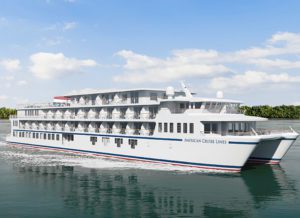
American Cruise Lines (ACL) is doubling down on the United States small cruise market with an order for 12 new ships.
Each vessel in the new fleet, developed under the name Project Blue, will hold up to 109 passengers and 50 crew — a figure that includes up to 20 credentialed mariners.
ACL subsidiary Chesapeake Shipbuilding Corp. of Salisbury, Md., designed the vessels. The yard has already begun construction on the first two ships, which are due out next year. Schedules for the remaining 10 vessels have not been released.
ACL specializes in U.S.-flagged cruising on small ships. The new vessels are the company’s smallest newbuilds in 15 years, and they feature a hybrid hull form that combines a catamaran and monohull design.
“The catamaran hull transitions to a monohull as you work aft down the length of the ship,” said Charles B. Robertson, president and chief executive officer of ACL. “It gives us a lot of flexibility. The goal was for it to be small, have a shallow draft, and for it to be stable enough to operate coastwise.”
The announcement of the new vessels comes as Chesapeake continues building the final two “modern riverboats” for ACL. The 345-foot, 175-passenger American Symphony and American Serenade are scheduled to enter service this spring. The company’s fleet now includes 15 vessels.
Covid-19 badly disrupted the international cruise industry, and it has still not fully recovered. Small-ship cruising, meanwhile, rebounded much more quickly as more Americans booked trips close to home last summer and fall. ACL ships don’t cross international borders, eliminating some Covid-19-related uncertainty. And they dock in city downtowns and village centers, letting passengers walk right ashore.
“We were one of the only cruise lines in the world that had its whole fleet running,” Robertson said of the 2021 cruising season. “Every vessel in the fleet, on every itinerary, is running this year.”
Capt. Dan Blanchard, owner and CEO of the Seattle-based tour company UnCruise Adventures, said the small-ship cruise industry has room to grow. He believes travel habits that started during the pandemic will stick around into the foreseeable future.
“People are looking at travel differently,” he said. “There is less interest in spending time on a 6,000-passenger cruise ship that just visits cities. There is a lot more interest, from all the data we are collecting, for people to be in smaller venues.
“That goes along with the whole experiential side of the industry, which was already growing in leaps and bounds before the pandemic,” he continued.
ACL is counting on that interest to continue, and with the new ships the company will be able to offer fresh itineraries. Robertson expects the new class of ships to visit destinations not currently accessible with ACL’s larger vessels. For example, he said one trip could include more towns and villages along the Maine coast.
The new ships will be powered by three Cummins engines, with electrical power delivered by Cummins generators. There will be three z-drive thrusters at the stern, with slow-speed maneuvering support from twin bow thrusters.
The interior of the new ships will have a look and feel like ACL’s modern riverboats. Studio DADO of Miami will provide the interior design. The vessels will have 56 staterooms and multiple lounges and restaurants. The aft deck will have space for kayaks and other adventure gear.
“We certainly are all in on it,” Robertson said of the new fleet. “We are big believers in what we are building.”

